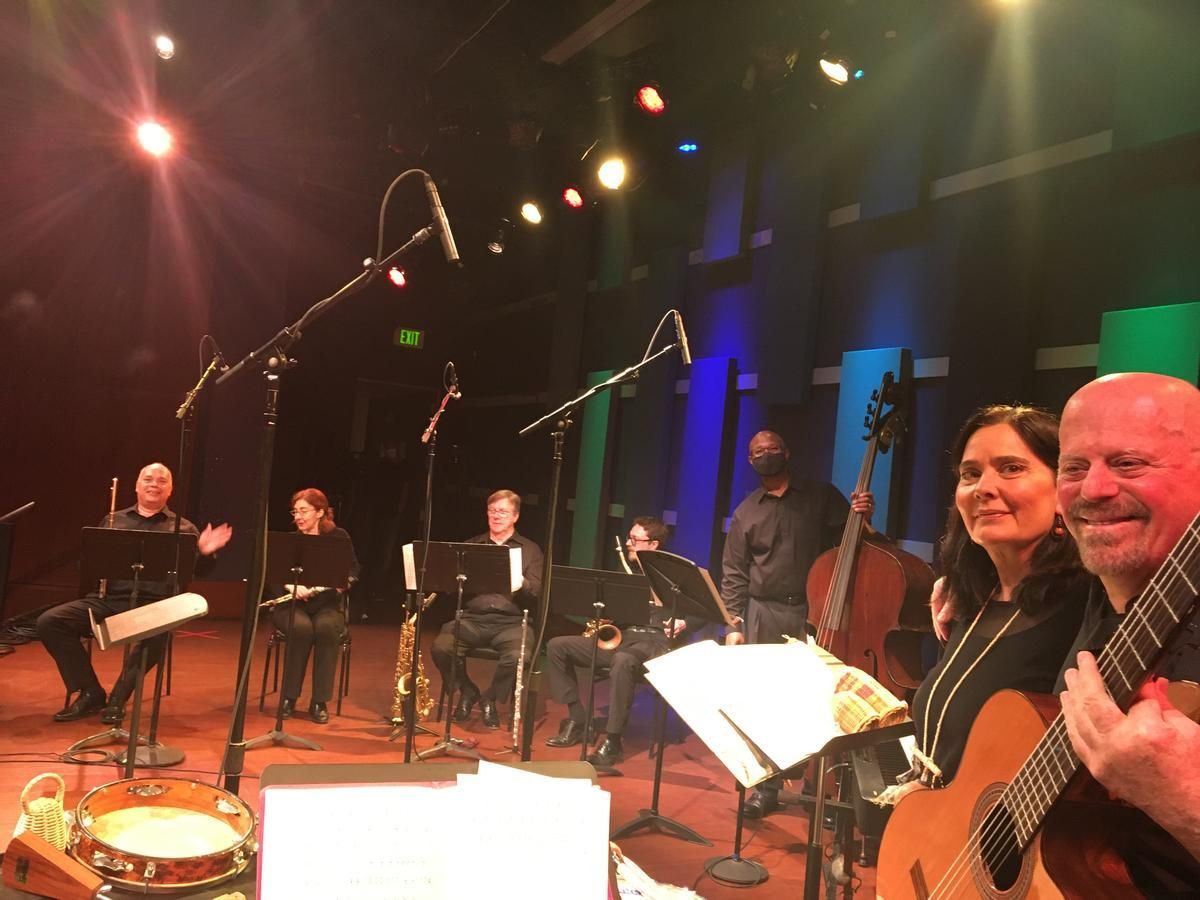II. Dia e Noite (Day and Night) – The piece begins with a young Indian messenger running in the forest, transporting a mysterious coconut. In the legend, there was endless daylight in the world. Night existed only at the bottom of lakes and rivers. The daughter of a powerful tribal chief, having been just married, longed to know the night. She expressed her wish to her husband who sent her back to the chief’s tribe. The father, deciding to grant her daughter’s wish, gave the warrior a tucumã fruit (a type of coconut), and instructed him not to open it. On the way back, intrigued by the noises coming from the coconut, the warrior decided to crack open the fruit. To his surprise, darkness and all creatures of the night were released. The Indian bride, not content with all that darkness, pulled a strand of her own hair and waving it, divided darkness in half. From that moment on, half the time would be day, and the other half would be night. The warrior, who could not complete his mission, was punished and transformed into a monkey.
¡CONEXÕES! Brazil
WEDNESDAY, JUNE 23, 2021 at 7pm
Virtual Livestreamed Event from Teatro Esperanza; recorded at World Cafe Live
Tickets $5 / FREE for Students & Seniors


20th- and 21st-Century Music by Brazilian composers
Orchestra 2001 returns to Teatro Esperanza as part of Esperanza Arts Center’s VOCES series, featuring live-streamed performances that spotlight the arts and traditions of Brazil. Enjoy authentic Brazilian food while watching VOCES at home and support our local Latino-owned restaurants.
This concerts series funded in large part by the Connelly Foundation.
PROGRAM:
Orchestra 2001 – Mark Loria, conducting
Heitor Villa-Lobos (1887-1959) – Sexteto místico
Clarice Vasconcelos Assad (b. 1978) – The Book of Spells
Orlando Haddad (b. 1953) – Lendas Amazônicas (Amazon Legends) premiere
Orlando Haddad's commission generously funded by the Steven R. Gerber Trust.
PERFORMERS:
Kevin Cope, guitar
David DiGiacobbe, flute
Fatma Daglar, oboe/English horn
Ron Kerber, saxophone/flute
Mark Allen, bass clarinet/tenor sax
Rong Tan, harp
Adriana Linares, viola
Douglas Mapp, bass
Nina Siniakova, keyboard
Patricia King Haddad, narration
Susan Lewis of WRTI interviewed Orlando Haddad to explore the instrumentation and inspiration behind his new work, Lendas Amazônicas (Amazon Legends) commissioned by Orchestra 2001.

Heitor Villa-Lobos (1887-1959) [Pronounced: AY-tor VEE-la-LOW-bosh]
Undoubtedly one of the most prolific and internationally in-demand South American composers in his time, Villa-Lobos wrote over 2,000 pieces for orchestra, chamber ensemble, and solo instrument with voice. These works were inspired by traditional Brazilian folk music and by the European classical tradition in which he was trained. His Bachianas Brasilieras, a set of nine Bach-inspired suites, is a popular example of this balance between musical worlds.
"I learned music from a bird in the jungles of Brazil, not from academies."

Clarice Assad (b. 1978)
A powerful communicator renowned for her musical scope and versatility, Brazilian-American Clarice Assad is a significant artistic voice in the classical, world music, pop and jazz genres, renowned for her evocative colors, rich textures, and diverse stylistic range. A prolific Grammy nominated composer, with over 70 works to her credit, her work has been commissioned by internationally renowned organizations, festivals and artists. A sought-after performer, she is a celebrated pianist and inventive vocalist. Ms. Assad has released seven solo albums and appeared on or had her works performed on another 30. As an innovator, her award-winning Voxploration Series on music education, creation, songwriting and improvisation has been presented throughout the United States, Brazil, Europe and the Middle East. With her talents sought-after by artists and organizations worldwide, the multi-talented musician continues to attract new audiences both onstage and off.

Orlando Haddad (b. 1953)
Orlando brings a wealth of influences not only from his country of Brazil but as a guitarist, vocalist, composer, songwriter, recording artist, and arranger. A native of Lavras, in the state of Minas Gerais, Orlando has been a bandleader since the age of 12. His father was a physician and his mother was a piano teacher. Orlando studied classical piano before moving to Rio de Janeiro, where he attended the Villa-Lôbos Institute of music, taking guitar lessons privately from Marcel Gilbert Pierren, a Swiss expatriate living in Rio.
In 1974 he came to the US to attend the University of North Carolina School of the Arts, where he graduated with a degree in Composition. Moving to Philadelphia in 1984, Orlando pursued more studies receiving a Masters of Science in Arts Administration from Drexel University in 1986, and a Masters in Composition from Temple University in 2002.
Orlando taught Brazilian Music at University of the Arts (UArts) for 10 years. His expertise has inspired invitations to teach courses, classes, and clinics at numerous universities in the US.
In addition to the collection of songs composed for and recorded with his Philadelphia-based bossa nova jazz band, Minas, Orlando has written 20th Century-style works: two song cycles, a chamber piece (Transparencies, performed by Rèlache), and 12-tone duets for oboe and viola. Orlando has written music for three documentaries and was commissioned to write arrangements for The Orpheus Club of Philadelphia, a choir of 80 men, and commissioned by Live Connections to write a suite, presented by Minas and the baroque ensemble Melomanie. His latest chamber music piece, Lendas Amazônicas was commissioned by Orchestra 2001 and will be premiered virtually in June of 2021.
Minas is working on a new album, “Beatles in Bossa”, featuring 14 Beatles songs reimagined in a Brazilian fashion.
Notes from Orlando Haddad about his new work, Lendas Amazônicas (Amazon Legends):
updated May 15, 2021
Composed by Orlando Haddad for Orchestra 2001, Lendas Amazônicas (Amazonian Legends) is a chamber music piece for flute, oboe, alto sax, tenor sax, piano, guitar, bass and percussion. The piece is based on legends told by the indigenous peoples of the Brazilian Amazon Region. Written in 5 movements, the composition portrays 7 legends presented in a musical language reflecting the composer’s Brazilian background of samba, bossa nova, and folk, as well as jazz and classical music.
I. Lamento de Jaci (Jaci’s Lament) – In Brazilian mythology and in Tupi-Guarani (the main language of the Brazilian indigenous people), Jaci is the God of the Moon, and Guaraci is the sun God. In this legend, Jaci is lamenting that the union with Guaraci cannot consummate. The two gods were in love, but their union was impossible because the heat of the sun would melt the world, whereas the weeping of the moon would flood the earth. Jaci, inconsolable, wept an entire night, inundating the land and forming the Amazon River.
III. Rondo – Rivers are the main channels of transportation in the Amazon rainforest. Presented here in Rondo form, the river leads us on an adventure, discovering three legends: Boto (Pink Dolphin), Iara (the Mother of the Waters), and Muriaquitã (a good luck charm).




